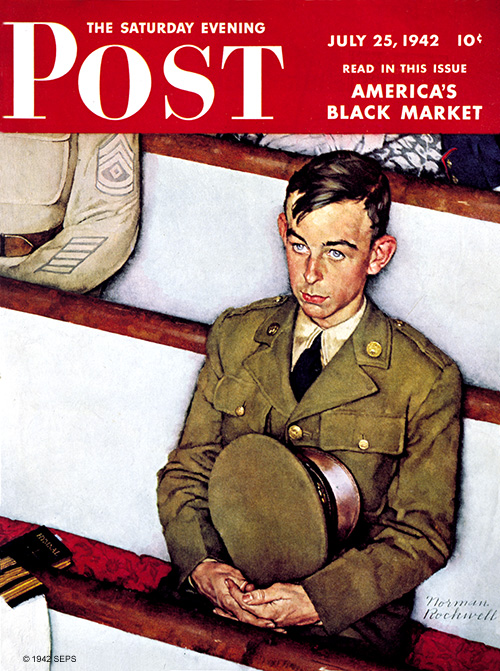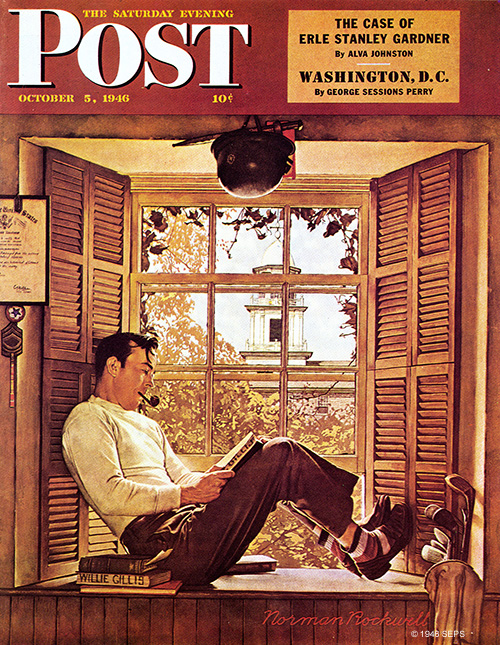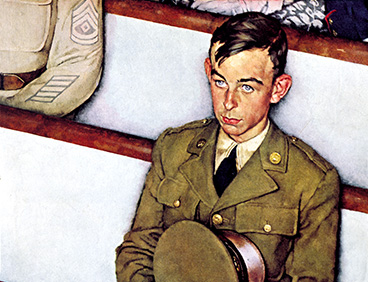“Willie Gillis in Church” by Norman Rockwell

Norman Rockwell
July 25, 1942
This Memorial Day, we remember Norman Rockwell’s WWII soldier, Robert Buck, who passed away May 22, 2011, with warmth and gratitude.
“Willie Gillis on KP” by Norman Rockwell

Norman Rockwell
April 11, 1942
Most artists depicted the WWII soldier as a big, strapping man with chiseled features. Rockwell wanted the boy next door. So he studied faces. “The model Rockwell used for Gillis was my wife’s uncle,” emailed Jarrod. “Apparently, they met in Vermont. He (Bob Buck) said that this guy wouldn’t stop staring at him and that he was about to knock his block off when the guy said he was Norman Rockwell and that he wanted to paint him.” By the time of this 1942 cover, many a soldier could identify with the homesick Willie eager for news from home. The war meant financial strains and spiraling costs for everything: it was with this issue that the price of The Saturday Evening Post rose from five to ten cents.
“Willie Gillis’ Package from Home” by Norman Rockwell

Norman Rockwell
October 4, 1941
Robert Buck said he was sixteen when he first posed for Rockwell, and both model and artist were surprised at the success of the Willie Gillis covers. This is the first of eleven covers of the “every soldier.” Nothing like a package from home to make you a popular guy. “Norman was a kind gentleman to work with,” Buck wrote. “I had no experience or training for modeling. Many poses or expressions had to be held for agonizing periods of time. Norman’s patience was terrific.” It sounds like the model showed great patience as well.
“Willie Travels” by Norman Rockwell

Norman Rockwell
June 26, 1943
This eighth cover from 1943 is ironic: A fakir with the power to charm cobras is astonished at Willie’s string trick. Looks like the small-town boy made it to the Middle East and possessed some charm himself. Rockwell was crushed when his “soldier” joined a branch of the Navy, leaving him without the model for his popular series. Ah, but Norman was clever, as we will see.
“Double Trouble for Willie Gillis” by Norman Rockwell

Norman Rockwell
September 5, 1942
When two young ladies check their mail at the same time, the result is trouble. Both have photos of our favorite soldier and each is signed, “Love, Willie.” Maybe you should stay in the war zones where it’s safe, Willie. This shows how smart Rockwell was to create another Gillis cover, using only a photo of Willie. It also shows how handy it was to have a good friend and neighbor like Post artist Mead Schaeffer, who happened to have a couple of pretty daughters to pose for the cover.
“Willie Gillis in College” by Norman Rockwell

Norman Rockwell
October 5 ,1946
The final Gillis cover was in October 1946. Our favorite soldier, looking different in civvies, is using his G.I. Bill of Rights to attend college. After finishing this cover in Vermont, Rockwell enlisted the aid of his model to haul the painting to the Saturday Evening Post offices in Philadelphia, where Bob Buck was treated like a celebrity. Mr. Buck, soldiers from different generations will identify with these portraits of military life. Rest in peace, Bob.
Become a Saturday Evening Post member and enjoy unlimited access. Subscribe now




Comments
Thanks for the pleasant memories.
Thanks for sharing the tribute and history of the Willie pics. The artwork is breathtaking as usual for Mr. Rockwell but they mean so much more knowing the history behind the work. I offer my sympathies to Bob’s extended family. That golden era will long be missed.